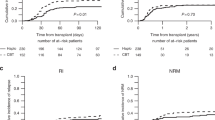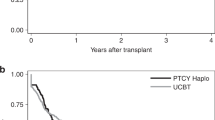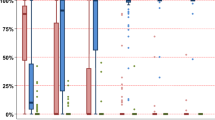Abstract
Primary graft failure (pGF) is a frequent complication following cord blood transplantation (CBT). For those patients who will not experience autologous recovery, salvage transplantation should be performed as early as possible. However, standardized treatment protocols for pGF, such as the optimal stem cell source, preparative regimen and the ideal time for salvage transplantation, have yet to be determined. Therefore, we analyzed 17 hematologic malignancy patients who received unmanipulated haploidentical peripheral blood (PB) and BM transplantation with reduced-intensity conditioning (RIC) as a salvage therapy for pGF after CBT. The median interval between the two transplantations was 38 days. The RIC regimen for salvage transplantation consisted of fludarabine, antithymocyte globulin, CY and low-dose TBI. The neutrophil and plt engraftments were achieved in 14 (82.4%) and 13 (76.4%) patients, respectively. The cumulative incidences of grades II–IV and grades III–IV aGVHD were 35.3% and 17.6%, respectively. The cumulative incidence of chronic GVHD was 29.4%. After a median follow-up of 43 months, 10 of 17 patients remained alive in CR. The cumulative incidence of TRM at 180 days was 29.4%. The probability of 3-year OS and leukemia-free survival was 57.5%. Our results show that unmanipulated haploidentical PB and BM transplantation under a RIC regimen is an effective treatment for pGF after CBT.
This is a preview of subscription content, access via your institution
Access options
Subscribe to this journal
Receive 12 print issues and online access
$259.00 per year
only $21.58 per issue
Buy this article
- Purchase on Springer Link
- Instant access to full article PDF
Prices may be subject to local taxes which are calculated during checkout


Similar content being viewed by others
References
Wagner JE, Gluckman E . Umbilical cord blood transplantation: the first 20 years. Semin Hematol 2010; 47: 3–12.
Laughlin MJ, Eapen M, Rubinstein P, Wagner JE, Zhang MJ, Champlin RE et al. Outcomes after transplantation of cord blood or bone marrow from unrelated donors in adults with leukemia. New Engl J Med 2004; 351: 2265–2275.
Rocha V, Labopin M, Sanz G, Arcese W, Schwerdtfeger R, Bosi A et al. Transplants of umbilical-cord blood or bone marrow from unrelated donors in adults with acute leukemia. New Engl J Med 2004; 351: 2276–2285.
Takagi S, Masuoka K, Uchida N, Ishiwata K, Araoka H, Tsuji M et al. High incidence of haemophagocytic syndrome following umbilical cord blood transplantation for adults. Br J Haematol 2009; 147: 543–553.
Narimatsu H, Matsumura T, Kami M, Miyakoshi S, Kusumi E, Takagi S et al. Bloodstream infection after umbilical cord blood transplantation using reduced-intensity stem cell transplantation for adult patients. Biol Blood Marrow Transplant 2005; 11: 429–436.
Yoshihara S, Ikegame K, Taniguchi K, Kaida K, Kim EH, Nakata J et al. Salvage haploidentical transplantation for graft failure using reduced-intensity conditioning. Bone Marrow Transplant 2012; 47: 369–373.
Lu DP, Dong L, Wu T, Huang XJ, Zhang MJ, Han W et al. Conditioning including antithymocyte globulin followed by unmanipulated HLA-mismatched/haploidentical blood and marrow transplantation can achieve comparable outcomes with HLA-identical sibling transplantation. Blood 2006; 15107: 3065–3073.
Ciceri F, Labopin M, Aversa F, Rowe JM, Bunjes D, Lewalle P et al. A survey of fully haploidentical hematopoietic stem cell transplantation in adults with high-risk acute leukemia: a risk factor analysis of outcomes for patients in remission at transplantation. Blood 2008; 112: 3574–3581.
Wang Y, Liu DH, Liu KY, Xu LP, Zhang XH, Han W et al. Long-term follow-up of haploidentical hematopoietic stem cell transplantation without in vitro T cell depletion for the treatment of leukemia: nine years of experience at a single center. Cancer 2013; 119: 978–985.
Di Bartolomeo P, Santarone S, De Angelis G, Picardi A, Cudillo L, Cerretti R et al. Haploidentical, unmanipulated, G-CSF–primed bone marrow transplantation for patients with high-risk hematologic malignancies. Blood 2013; 121: 849–857.
Mizutani E, Narimatsu H, Murata M, Tomita A, Kiyoi H, Naoe T . Successful second cord blood transplantation using fludarabine and cyclophosphamide as a preparative regimen for graft rejection following reduced-intensity cord blood transplantation. Bone Marrow Transplant 2007; 40: 85–87.
Fernandes J, Rocha V, Robin M, de Latour RP, Traineau R, Devergie A et al. Second transplant with two unrelated cord blood units for early graft failure after haematopoietic stem cell transplantation. Br J Haematol 2007; 137: 248–251.
Scrucca L1, Santucci A, Aversa F . Regression modeling of competing risk using R: an in depth guide for clinicians. Bone Marrow Transplant 2010; 45: 1388–1395.
Chan KW, Grimley MS, Taylor C, Wall DA . Early identification and management of graft failure after unrelated cord blood transplantation. Bone Marrow Transplant 2008; 42: 35–41.
Kato M, Matsumoto K, Suzuki R, Yabe H, Inoue M, Kigasawa H et al. Salvage allogeneic hematopoietic SCT for primary graft failure in children. Bone Marrow Transplant 2013; 48: 1173–1178.
Fuji S, Nakamura F, Hatanaka K, Taniguchi S, Sato M, Mori S et al. Peripheral blood as a preferable source of stem cells for salvage transplantation in patients with graft failure after cord blood transplantation: a retrospective analysis of the registry data of the Japanese Society for Hematopoietic Cell Transplantation. Biol Blood Marrow Transplant 2012; 18: 1407–1414.
Chang YJ, Xu LP, Liu DH, Liu KY, Han W, Chen YH et al. Platelet engraftment in patients with hematologic malignancies following unmanipulated haploidentical blood and marrow transplantation: effects of CD34+ cell dose and disease status. Biol Blood Marrow Transplant 2009; 15: 632–638.
Handgretinger R, Klingebiel T, Lang P, Gordon P, Niethammer D . Megadose transplantation of highly purified haploidentical stem cells: current results and future prospects. Pediatr Transplant 2003; 7: 51–55.
Huang W, Li H, Gao C et al. Unmanipulated HLA-mismatched/ haploidentical peripheral blood stem cell transplantation for high-risk hematologic malignancies. Transfusion 2012; 52: 1354–1362.
Sumi M, Shimizu I, Sato K, Bo J, Wang Q, Zhao Y et al. Graft failure in cord blood transplantation successfully treated with short-term reduced-intensity conditioning regimen and second allogeneic transplantation. Int J Hematol 2010; 92: 744–750.
Jabbour E, Rondon G, Anderlini P, Giralt SA, Couriel DR, Champlin RE et al. Treatment of donor graft failure with nonmyeloablative conditioning of fludarabine, antithymocyte globulin and a second allogeneic hematopoietic transplantation. Bone Marrow Transplant 2007; 40: 431–435.
Larocca A, Piaggio G, Podesta M, Pitto A, Bruno B, Di Grazia C et al. Boost of CD34+-selected peripheral blood cells without further conditioning in patients with poor graft function following allogeneic stem cell transplantation. Haematologica 2006; 9: 935–940.
Remberger M, Ringden O, Ljungman P, Hagglund H, Winiarski J, Lonnqvist B et al. Booster marrow or blood cells for graft failure after allogeneic bone marrow transplantation. Bone Marrow Transplant 1998; 22: 73–78.
Crawley C, Szydlo R, Lalancette M, Bacigalupo A, Lange A, Brune M et al. Outcomes of reduced-intensity transplantation for chronic myeloid leukemia: an analysis of prognostic factors from the Chronic Leukemia Working Party of the EBMT. Blood 2005; 106: 2969–2976.
Aoudjhane M, Labopin M, Gorin NC, Shimoni A, Ruutu T, Kolb HJ et al. Comparative outcome of reduced intensity and myeloablative conditioningregimen in HLA identical sibling allogeneic haematopoietic stem cell transplantation for patients older than 50 years of age with acute myeloblastic leukaemia: a retrospective survey from the Acute Leukemia Working Party (ALWP) of the European group for Blood and Marrow Transplantation(EBMT). Leukemia 2005; 19: 2304–2312.
Luznik L, Jalla S, Engstrom LW, Iannone R, Fuchs EJ . Durable engraftment of major histocompatibility complex-incompatible cells after nonmyeloablative conditioning with fludarabine, low-dose total body irradiation, and posttransplantation cyclophosphamide. Blood 2001; 98: 3456–3464.
Barker JN, Weisdorf DJ, DeFor TE, Blazar BR, Miller JS, Wagner JE . Rapid and complete donor chimerism in adult recipients of unrelated donor umbilical cord blood transplantation after reduced-intensity conditioning. Blood 2003; 102: 1915–1919.
Moscardó F, Sanz J, Senent L, Cantero S, de la Rubia J, Montesinos P et al. Impact of hematopoietic chimerism at day +14 on engraftment after unrelated donor umbilical cord blood transplantation for hematologic malignancies. Haematologica 2009; 94: 827–832.
Song K, Sun Z, Liu H, Geng L, Ding K, Wang X et al. Primary research on unrelated double and implantation kinetics. Hematology 2013; 18: 253–259.
Acknowledgements
This work was supported by grants from the National Natural Science Foundation of China (31101006) and Anhui Provincial Scientific and Technological Projects Foundation (11010402164).
Author information
Authors and Affiliations
Corresponding author
Ethics declarations
Competing interests
The authors declare no conflict of interest.
Rights and permissions
About this article
Cite this article
Tang, B., Zhu, X., Zheng, C. et al. Successful early unmanipulated haploidentical transplantation with reduced-intensity conditioning for primary graft failure after cord blood transplantation in hematologic malignancy patients. Bone Marrow Transplant 50, 248–252 (2015). https://doi.org/10.1038/bmt.2014.250
Received:
Revised:
Accepted:
Published:
Issue Date:
DOI: https://doi.org/10.1038/bmt.2014.250
This article is cited by
-
Non-relapse cytopenias following allogeneic stem cell transplantation, a case based review
Bone Marrow Transplantation (2022)
-
Outcomes of salvage haploidentical transplantation using posttransplant cyclophosphamide for graft failure following allogeneic hematopoietic stem cell transplantation
International Journal of Hematology (2022)
-
Prognostic factors for neutrophil engraftment after haploidentical cell transplantation with PT-Cy in patients with acute myeloid leukemia in complete remission, on behalf of the ALWP-EBMT
Bone Marrow Transplantation (2021)
-
Comparison of immunosuppressant regimens in salvage cord blood transplantation for graft failure after allogeneic hematopoietic stem cell transplantation
Bone Marrow Transplantation (2021)
-
Salvage HLA-haploidentical hematopoietic stem cell transplantation with post-transplant cyclophosphamide for graft failure in non-malignant disorders
Bone Marrow Transplantation (2021)



